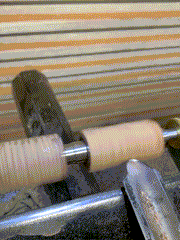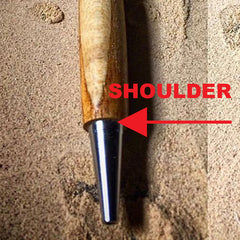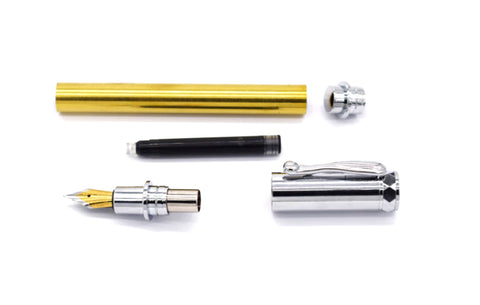Best Wood Pens: A Buyer's Guide
Aug 12, 2020
Over the last few months, I’ve been researching and making Koa wood pen prototypes for the KoaWood Ranch store. My intent and desire was to source and provide the best possible hand-turned Koa wood pens available. This put me in the position of asking and having to answer the question “What makes the best wood pen?"
The best wood pen is determined by four factors; craftsmanship, species of wood, quality of fittings, and preferred pen type. Artistry is ultimately going to determine whether or not the pen looks good. The wood and hardware will influence design. And the pen-type will dictate how it writes.
Since delving into the world of wood pens I learned a lot more than I bargained for. The diversity of wood pen options is more than I could ever realize and the number of makers and collectors out there is endless. But with the question of “What makes the best wood pens?” at the forefront of my mind I’ll share with you some of what I learned and the questions you should ask yourself when buying a handcrafted wood pen.
Choose a Good Craftsman
 The craftsman must take into account the type of wood he or she is working with, the ideal speed for which the wood rotates (RPM), and the appropriate cutting tool. He or she must also be adept at adjusting body and tool pressure to make the appropriate cuts. It’s an art-making that comes with time and practice.
The craftsman must take into account the type of wood he or she is working with, the ideal speed for which the wood rotates (RPM), and the appropriate cutting tool. He or she must also be adept at adjusting body and tool pressure to make the appropriate cuts. It’s an art-making that comes with time and practice.
The process of pen making requires the skill of lathe turning and a particular eye for detail. Lathe turning is a machining process used to carve and shape round and cylindrical parts. The cutting tool is moved linearly while the workpiece (wood) spins. This allows the artist to sculpt the wood into the desired form.
The difference between a novice pen turner and a skilled one is going to be in the details. The ability to keep congruency with the shape and form the wood into something that is appealing to the eye is something that only an expert woodturner can produce. Like art, the expertise of the creator will determine the quality of the design.
In the photos below you can see the difference in detail when comparing a novice’s work to a professional. In the first photo (A) you can see that the pen maker didn’t shape the front of the pen to match up with the metal tip fitting. He or she left an unwanted shoulder. In the second photo (B), there is a tiny gap left between the wood and the metal fitting. And in the third example (C), the professionally turned wood pen is nicely shaped and contoured to match and align with the metal tip. This is clean work and the attention to this detail makes all the difference.
| (A) | (B) | (C) |
 |
 |
 |
When making a wood pen purchase, you'll want to inspect the details of the pen and ensure the wood is tailored to its fittings and hardware. You should see no gaps, chips, or sharp uneven joints.
Wood Preference
The craftsman starts with a wood blank and wood the choice varies in the world of wood pens, from the inexpensive maple and alder to the exotics like Hawaiian Koa and Burls. The raw materials for the inexpensive woods are relatively cheap, averaging a few dollars for a singular pen blank, but increase as you get into the rarer woods.
Burl - tree growth in which the grain has grown in a deformed manner. It is commonly found in the form of a rounded outgrowth on a tree trunk or branch that is filled with small knots from dormant buds.
Exotic woods like Hawaiian Koa or Burls, because of their known unique wood properties and unique grain patterns, are significantly more expensive. These raw materials can cost the pen maker as much as $25 to $30 for one blank. (Thankfully at KoaWood Ranch, we source our own wood so we can competitively price our pen blanks and finished pen turnings.)
The high cost of the wood ultimately drives up the cost of the finished pen. Exotic wooden pens, for example, can range anywhere from $100 to a few hundred dollars per pen vs. $20 - $50 for a pen made of common woods. The type of wood and its grain quality is a key factor that influences the finished pen price.
Below is a table that charts out the cost of common wood pen blanks; ranging from the inexpensive ($) to the most expensive ($$$$).
|
$ LOW
|
$$
|
$$$
|
$$$$ HIGH
|
|
|
|
|
Wood and Resin

I must note that although this article is mostly looking at handmade "wood" pens, the combination of acrylic resin with wood is a growing trend among pen makers (and all woodworking). Many are fueling this trend with distinct and unique eyecatching designs (as exemplified in the photo above; Koa wood and turquoise blue resin).
Ever since I started offering Koa and resin pens at the KoaWood Ranch store, they've become one of our best sellers. These hybrid creations are available in limitless colors and blends. These pens are typically higher in price because of the added labor and cost of resin materials needed to create these beautiful pieces.
Pen Hardware and Fittings

There are a number of different manufacturing companies that make wood pen fittings. Most of the commonly available pen kits (hardware and fittings) are source from prominent woodworking establishments like Rockler and Woodcraft. Some of the more common and simple pen kit styles include the Slimline (or Slim) pen. This is classic style pens.
| Slimline (or Slim) |
 |
As pen gain weight and components get more detailed, the cost of the hardware can run up the cost when compared to their simple style counterparts. This premium hardware is typically more substantial and includes some fountain and cigar pens. As you can see in the photos below, both have more stylized mid-body and end detail.
| Fountain | Cigar |
 |
 |
The pinnacle of hand-turned pens is those with custom fittings, either handcrafted fittings or custom made/designed by or for the artist. Some of these works are truly awe-inspiring and the writing instruments considered heirloom quality. The labor goes beyond just the turning, but into the crafting of each detail. Pens in this category can range in price that exceeds $2k.
Hardware and fittings decide the style of the pen and the decision for which style to choose will ultimately be a personal one.
How Would You Like it to Write?
Aesthetics aside, it’s just as important, if not more important to consider the pen type, and how it will write. Below are three common types that you'll have to choose from, do you prefer a ballpoint, rollerball, or fountain?
Ballpoint pens, as the title describes has a ball mechanism at the tip of the pen that distributes ink. It’s the most common type and contains oil-based ink. As a result, the ink is thick, dries quickly, and uses less ink. However, it can clump and it may require you to have to press down hard on the paper to get it to write. I think we can all relate to the “scribble test,” when trying to get this type of pen to write.
 Rollerball pens are similar in that they have a ball mechanism at the tip. However, the ink is water-based. The benefit is that it will glide smoother and not dry as quickly as oil-based inks. This makes it more comfortable to write with. That said, there is a tendency for the ink to smudge because of the delay in drying time. Because it flows quickly and soaks into the paper, the ink tends to run out more quickly than ballpoint pens.
Rollerball pens are similar in that they have a ball mechanism at the tip. However, the ink is water-based. The benefit is that it will glide smoother and not dry as quickly as oil-based inks. This makes it more comfortable to write with. That said, there is a tendency for the ink to smudge because of the delay in drying time. Because it flows quickly and soaks into the paper, the ink tends to run out more quickly than ballpoint pens.
Requiring a bit more knowledge and experience to use, the Fountain pen is perhaps the most unique and classy of all writing types. When made with wood, the organic warmth accentuates its sophistication.
Fountain pens typically use disposable dye-based ink cartridges.
Interesting Fact: The nib of a Fountain pen refers to the tip of the pen. The larger the nib size, the heavier flow of ink.
Fountain pens are best when writing on thicker paper because of the ink flow. Typically heavier, you wouldn’t want the ink flow to bleed through thinner paper. In terms of how they actually write, it does take a bit of practice to use. Holding it right, keeping the correct 45-degree writing angle, and applying the proper pressure will affect the writing experience.
You Are the Judge
Finding the best wood pen can be a daunting task. Whether you’re buying a pen for yourself, or looking to purchase one as a gift, you want to make an educated purchase and understand the variables that go into its pricing and the making of a quality pen. When choosing what wood pen will best suit your needs, take into consideration the four key elements outlined in this article:
- Craftsmanship - What is the quality of detail?
- Wood Choice - Common wood or rare and exotic?
- Pen Fittings - What is your design preference?
- Writing type - How would you like it to write?
The cost too, of course, will be a deciding factor on what's the best pen for you. Typically, and rightfully so, the craftsmanship and wood choice are the biggest variables in determining the price. I estimate that a quality hand-made pen, from a professional pen maker, is going to cost you anywhere between $85 - $150...and potentially much higher for custom fittings and details.
The best wood pen is a subjective decision and what’s best for you may not be for another. Using the guide and questions shared in this article you should be able to make a decision you’ll be happy with, get the most out of your investment, and keep you satisfied with your wood pen choice.




